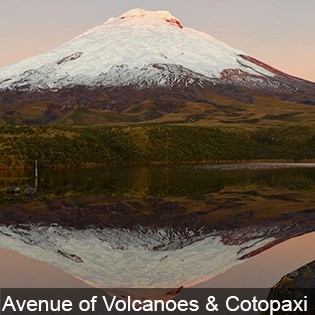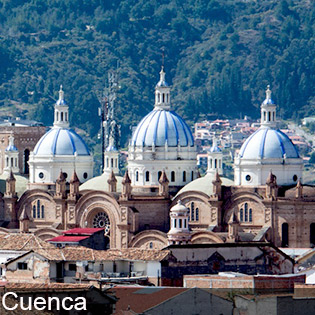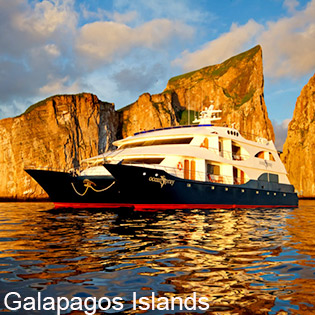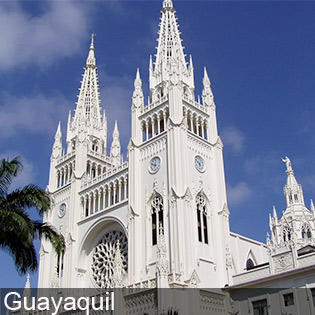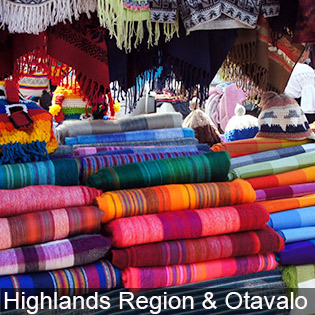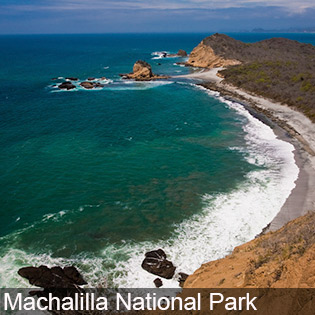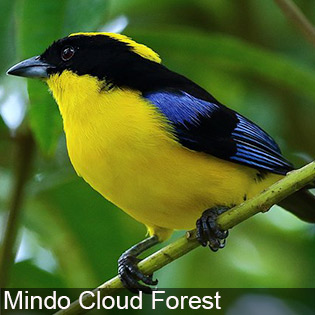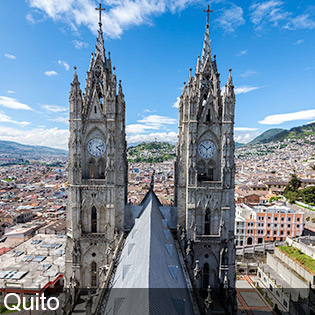ECUADOR: Region by Region
Welcome to our Region by Region section. This section is intended to provide more details of each county’s regions, highlighting the region’s attributes and points of interest, including what to see, best time to see it; suggested length of stay, and more. Moreover, this section provides the independent traveler the opportunity to consider what cities and regions interest them most. While our Pre-designed tour menu provides a wide range of suggested popular tour programs, the Region by Region sections allows you to custom-design the tour of your choice.
Amazon, Ecuador’s Oriente
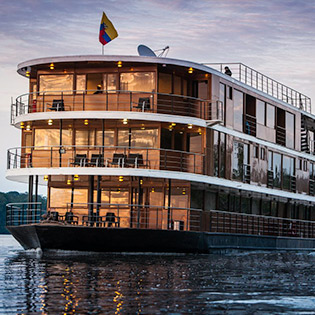
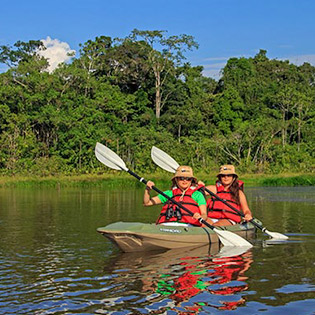
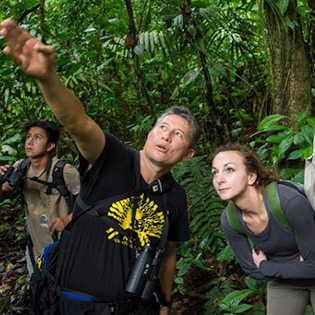
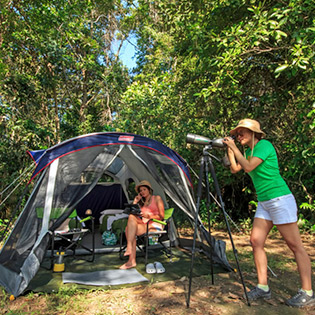
Overview
The Amazon is the world’s largest remaining tropical rainforest stretching from eastern Ecuador to the Atlantic Ocean, covering an area almost as large as the continental USA. Blessed with one of the highest biodiversity indices, Ecuador also has one of the world’s highest rates of deforestation, estimated at over 300,000 hectares (3%) per year. Responsible ecotourism in the Amazon could help reduce deforestation. Ecuador’s Amazon, popularly known as the Oriente, is on the eastern side of the Andes, separated from the rest of the country by unbroken mountains. Ecuador’s Amazon offers some of the best and most accessible Amazon travel experience. A mere 30-minute flight from Quito lands you in Coca the capital of province of Orellana located in the Amazon Rainforest at the confluence of the Coca River and the Napo River, gateway to most jungle lodges and cruises. The two main protected areas of Ecuador’s Amazon are the Yasuni National Park and Cuyabeno Wildlife Reserve situated on either side of the Napo River which merges with other rivers to form the mighty Amazon. Both, the Cuyabeno Reserve, and Yasuni National Park, contain impressive flora and fauna boasting high diversity of animals and plants. A recent new study found that Yasuni National Park that sits atop major oil reserves, is home to the most diverse array of plants and animals in South America and possibly the planet.
Recommended Stay
Three to seven nights
When to go
The Amazon region normally has a warm, humid and rainy climate. Average temperature varies from 72°F to 80°F. The drier season is generally November to February but varies by region.
Highlights
Avenue of the Volcanoes & Cotopaxi
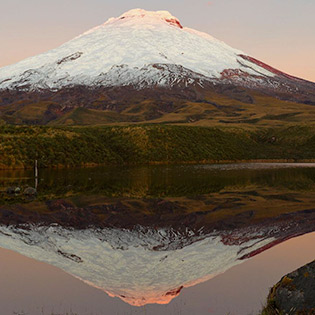
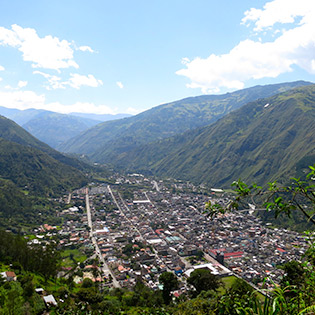
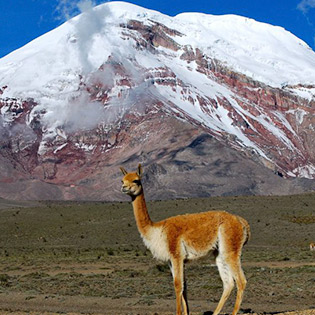
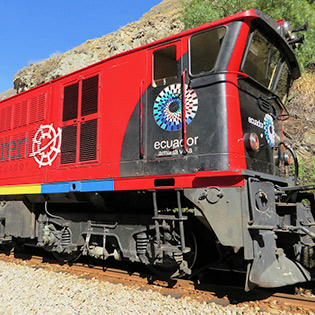
Overview
Avenue of the Volcanoes region is the central belt of Ecuador, running from North to South and including the Andes mountain range. Running for 200 miles south of Quito between two parallel cordilleras. The region contains several snowcapped mountain peaks, including Chimborazo, an extinct volcano rising 6,297 meters and the farthest point from the center of the earth. Cotopaxi, the second highest active volcano in the world could well be the world’s most beautiful volcano. It stands in majestic and solitary splendor, surrounded by the tawny and wind-swept páramo (highlands). This region is principally known for agriculture, including cut flower production, a major export. Several of Ecuador’s principal cities are located here, including the capitol of Quito with its well preserved colonial center, the beautiful historical city of Cuenca in the south, Otavalo with its famous indigenous market, and the towns of Baños and Riobamba. Several of Ecuador’s major national parks are found in this region, along with a number of cloud forest reserves offering numerous opportunities for hiking, trekking, birdwatching and a number of other outdoor adventure activities. Culturally rich, this region is also home to a number of indigenous populations who maintain many of their ancestral traditions. A cool but comfortable climate with plenty of sun in the mornings and frequent rain in the afternoon is typical in this region
Recommended Stay
Two to five nights.
When to go
Straddling the Equator as its name suggests, Ecuador is a year-round destination. However, there are different regional zones that have their own microclimates and best times to visit. Generally speaking, you may also wish to bear in mind the peak tourism season, which approximately from mid-December to end of January and again from June to August. The Andean Highlands including the capital Quito, has a dry season from June to September, when days are usually warm and sunny. Outside of these months you may experience some rain, but not every day. Due to the altitude the nights can be mild, but average maximum daytime temperature is around 18ºC or 64ºF.
Highlights
- Cotopaxi National Park the most imposing volcano is the perfect cone shape of Cotopaxi, the highest active volcano in the world. At its foot, its eponymous national park is an ideal place for spending the night in one of the local haciendas from where you can enjoy a gentle hike, a visit to a rose plantation or some horseback riding. The surrounding countryside is also peppered with indigenous villages which play host to colorful local markets on different days of the week.
- Baños & Riobamba heading east you can visit the pretty spa town of Banos, resting at the foot of the temperamental Tungurahua volcano with thermal hot springs bubbling out of the side of volcano. If you continue down the Avenue of Volcanoes you will reach the town of Riobamba, which lies in the shadow of Chimborazo, the country’s highest volcano. This is the starting point for the dramatic ‘Devil’s Nose’ train journey. As the train wends its way south through the mountains and lakes, it reaches a steep cliff where a series of thrilling switchbacks commence that allow the train to zigzag down the track, carved out of the sheer rock face.
- Volcán Chimborazo is the highest peak in Ecuador and it looms over the provinces of Chimborazo, Bolívar and southern Tungurahua, dominating the landscape. The Reserve Producción Faunística Chimborazo (Chimborazo Fauna Reserve), which surrounds the mountain, is the place to visit for views, high-altitude hiking, and to see the way of life of the remote, chilly indigenous villages in the area. The vast reserve is home to vicuña, llama, and alpaca; the latter are also prized livestock for local people. Foxes and deer are seen here, condors often soar overhead, and this is one of the few places to see the giant hummingbird. High-altitude polylepis forests are also a fascinating feature, as are the pre-Inca sites of worship on the mountain's flanks, where local villagers still make ritual offerings.
- Alausí was once used as a resort to escape from the heat of Guayaquil, and has a charming feel, with impressive mountain views and a quiet way of life except for market day on Sunday. It is most famous for the legendary Nariz del Diablo (Devil's Nose) railroad that switchbacks between here and Sibambe, dropping precipitously. The railroad used to run all the way to Guayaquil but many switchbacks were washed away in the El Niño storms of 1982–3.
Cuenca


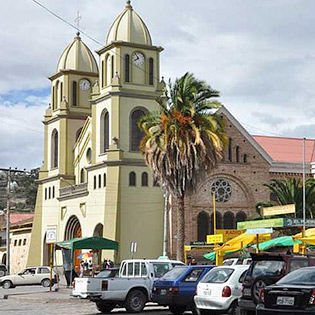
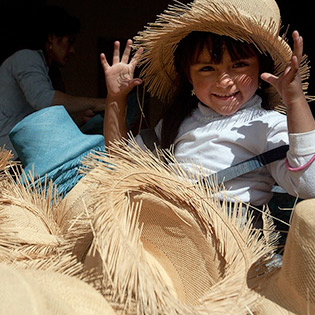
Overview
Cuenca is Ecuador’s colonial masterpiece. Its rich past is evident in graceful, flowered courtyards, shady plazas, ironwork balconies, museums, and religious art treasures all recalling the city’s Spanish heritage. Cuenca is also home of the famed “Panama Hat,” originally woven here by Ecuadorians for workers building the Panama Canal. Markets and small artisan shops throughout the city sell the famed hats, leather, pottery, and distinctive, handcrafted jewelry. Beyond the city, Ingapirca, the Inca Empire’s northernmost major ruin, awaits the visitor as do many traditional villages and nearby national parks.
Recommended Stay
Two nights
When to go
The Ecuadorian Highlands are blessed with a balmy climate year-round characterized by warm days, cool nights and steady temperatures averaging 65F. Best time to visit is during dry season (June-October) although rainy season normally offers sunny mornings and afternoons with potential evening showers.
Highlights
- Colonial Architecture: Cuenca is one of the best preserved colonial cities in the Americas.
- Ingapirca: Ecuador’s most important Inca site is an hour’s drive outside town.
- Gualaceo and Chordeleg: Nearby indigenous villages popular as producers of fine traditional handicrafts.
- Laja National Park: Excellent hiking and bird watching.
Galapagos Islands
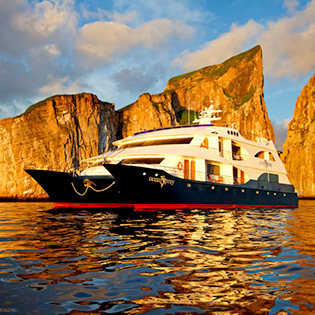
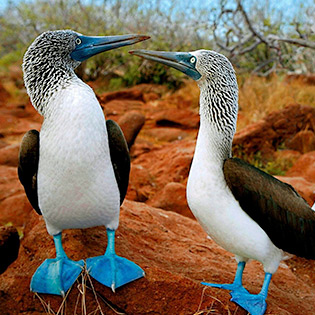

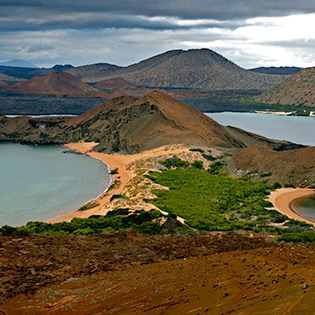
Overview
The fascinating Galapagos Archipelago is located in the Pacific Ocean, 600 miles west of Ecuador’s mainland, about a 2 hours flight from Guayaquil and composed of 19 main islands plus over 40 small islets. While historically the Galapagos is most closely associated with Charles Darwin, the famous English naturalist and geologist, well-known contributions to evolution theory who visited the islands in 1835. But in reality the Galapagos were discovered in 1535 by Fray Tomás de Berlanga, the first bishop of Panama, who happened upon the islands by pure chance during a sailing voyage to Peru. Although the islands at times served as a pirate refuge, the Galapagos were not colonized until the 19th century as a whaling station, and even as a penal colony. The archipelago is volcanic in origin dating back millions of years with incredible geological formations including lava flows, spatter cones, blowholes, tunnels, craters, and beaches of all colors and shapes. Some islands feature imposing volcanoes that become active sporadically, offering spectacular views of incandescent lava rivers flowing into the ocean. Main attraction is the unique opportunity to interact with wildlife at close range. The Galapagos wildlife was protected from human contact or major predators for hundreds of years and thus failed to create the natural fear of humans, meaning you can observe these beautiful creatures from surprisingly close range in their natural habitat. This provides opportunities to swimming with sea lions, snorkeling with penguins, sharing trails with blue and red-footed boobies, and sunning on the beach beside inquisitive iguanas is all part of the experience.
Recommended Stay
Four to seven nights.
When to go
The Galapagos is a year ‘round destination with two distinctly different seasons regulated by the Humboldt and Panama ocean currents. Dry season (June-November) brings cooler water and air temperatures, trade winds, and some moisture to higher elevations. Wet season (December-May) is warmer, with blue skies, and occasional showers.
Highlights
- Galapagos Cruises: The islands are traditionally visited aboard ships and yachts that cruise from three (3) to eleven (11) nights. We recommend vessels based on each client’s experience preferences and requirements. Most of the yachts carry 16-pasenger, with larger vessels carrying 40 to 90-pasengers, with variations in the middle.
- Land Based Galapagos Tours: Land-based tours are an attractive alternative to enjoy the Galapagos Islands with your family or friends. Unlike specified dates of departure for cruises, land based programs are offered anytime because they utilize hotels instead of cruise vessels. They offer day trips to close by islands and are often used for extensions to the cruises, especially for those wanting to scuba dive on the islands.
- Snorkeling: A highlight for many visitors to the Galapagos Islands, snorkeling is the chance to get up-close and personal with the wildlife of the seas.
- SCUBA Diving: To really go deep into the hidden world of the Galapagos suit up and dive down on a scuba adventure to view white-tip sharks, marine iguanas, penguins, golden rays, hammerheads and even whale sharks. Some of the best spots include Wolf Island and Darwin Island. Please note that you require to be a licensed diver. You can sign up for a scuba diving course (PADI) on the islands in advance, but without previous training you won't be able to make some of the advanced dives available. It is best to train as a scuba diver before you visit the islands to make the most of this unique location.
- Wildlife Observation: Something truly incredible about the Galapagos Islands is that the wildlife there has evolved with comparatively little human contact or major predators for hundreds of years. And, a healthy fear of humans have never developed, meaning you can observe these beautiful creatures from surprisingly close range in their natural habitat.
Guayaquil
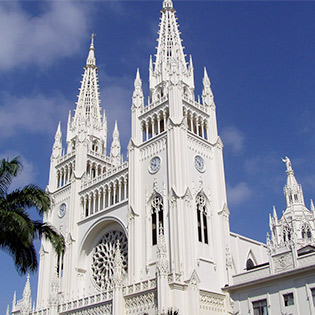
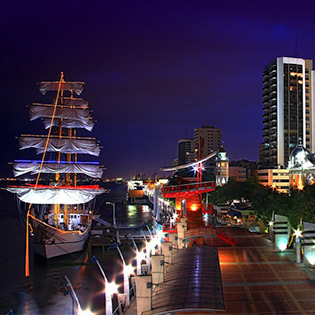
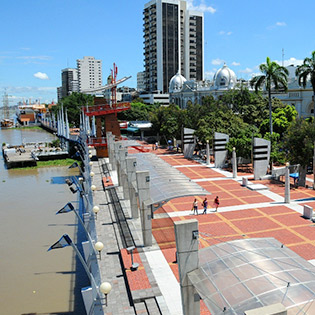
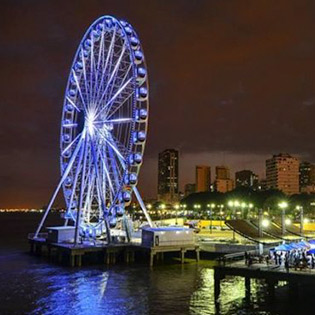
Overview
Guayaquil is Ecuador’s largest city is primarily a commercial center and major Pacific port. Lying beside the Guayas River, the city features a recently inaugurated riverside promenade, popular restaurants, parks, several fascinating museums, and theaters. The city’s international airport is the main gateway for trips to the Galapagos Islands and to neighboring Peru.
Recommended Stay
One night
When to go
The region is warm and humid with temperatures averaging 76F to 90F. Rainy season (December-May), is warmer and very muggy. Dry season (June-November) is less humid but by no means dry.
Highlights
Highlands Region & Otavalo
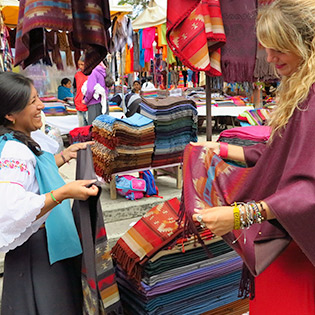
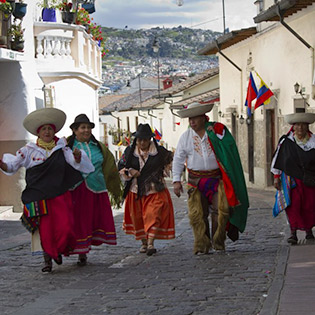
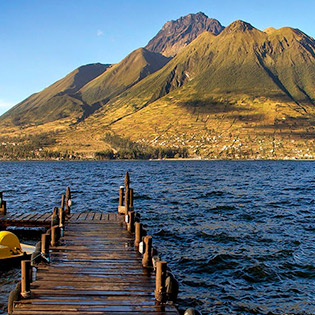

Overview
The Andean region (also known as the Sierra and the Highlands) is the most visited region in the country. Its cultural and natural diversity spans grassy highlands (páramo), cloud forests, mountain lakes, active volcanoes, thermal baths, Indian markets, colonial towns and haciendas. Running the length of Ecuador and splitting the country into two from north to south the mountains and valleys of the high Andes form the heart of Ecuador. Quito, the capital of the country, is located at 2,900 meters in a valley on the western slopes of Pichincha volcano where you can find countless cities and towns to visit and stay at, as one travels north to south in the highlands. Not surprisingly, this region possesses Ecuador's most developed tourist industry, providing a wide range of accommodations, culinary options, shopping opportunities and cultural festivals, all easily accessible from the capital of Quito. Otavalo and Baños are high on the list of places to visit, boasting an extensive infrastructure supporting tourism.
The Otavalo Market, which makes this market town famous, is undoubtedly one of the most important and spectacular markets in all of Latin America. Otavalo is attractive to visitors for both, its outstanding shopping, and its cultural significance. Local people use market day much the way their ancestors did during Ecuador’s pre-Colombian history. The Otavalo market is a fascinating way to experience traditional Ecuadorian culture and traditions of the Andes.
Recommended Stay
Two to three nights
When to go
Ecuador is considered a year-round destination. However, in Quito and the highlands the weather is coolest June through September (the dry season), but it's only a few degrees colder than during the rest of the year. Keep in mind that although Quito is practically on the Equator, the temperature can get quite cool because it's at such a high altitude. The city has an average high of 19°C (66°F) and an average low of 10°C (50°F). Throughout the rest of the highlands, the temperature is similarly consistent, with average highs and lows mostly determined by the altitude.
Highlights
- Otavalo Handicrafts Market: Plaza de Ponchos, the nucleus of the crafts market, is filled every day with vendors selling woolen goods, such as rugs, tapestries, blankets, ponchos, sweaters, scarves, gloves and hats – as well as embroidered blouses, hammocks, carvings, beads, paintings, woven mats and jewelry made from tagua nut (also known as vegetable ivory). But it metastasizes on Saturday, official market day, swelling into adjacent roads and around half of the town center.
- Peguche Waterfall (free entry) is a nice 18m waterfall, situated in a small park some 3km north of Otavalo. This is a sacred place for the Indians as they have a close relationship with nature, especially mountains, water and certain trees. Solstice celebrations take place at the falls around the 21st of June.
- Imbabura Mountain is located 60km north of Quito, near Otavalo and San Pablo Lake. With its 4620mts it is one of the highest mountains in Northern Ecuador, and in local legend it is considered the father of the indigenous people and culture: the "Taita" (father), as they call him, is the protector of the Indians, symbol of hardness and virility; During droughts, the locals carry out rituals on the mountain or in other sacred places to ask for his help. Imbabura can be climbed, with the easiest (but still challenging!) ascend route from the villages of La Esperanza and San Clemente east of Ibarra. Tour operators in Otavalo can provide transport and guides. The climb is also possible without a guide.
- San Pablo Lake lies 3.5 km southeast of the center of Otavalo at the feet of Imbabura Mountain. It is one of the most visited and largest lakes in Ecuador. Imbakucha and Chicapán are Kichua names for the lake. It is possible to rent Kayaks or go on boat trips at the Parque Aquático near the village of Araque.
- Cuicocha Lake is located 14 km northwest of Otavalo, at the base of Cotacachi Mountain. It is a deep volcanic crater that is 4km long and 3km wide. In the center of this lake are three domes of volcanic rock that form two islands covered with vegetation and separated by a water channel, called “channel of dreams". Its name derives from a pre-inca language: "Tsui cocha" meaning "lagoon of the gods."
- Cotacachi Mountain with its height of 4.939mts occupies the position N° 11 on the list of Ecuador´s highest mountains. Located 18km northwest of Otavalo, it is part of the Ecological Reserve "Cotacachi-Cayapas". For the indigenous people this mountain is a woman whose full name is: Maria Isabel Nieves Cotacachi. There are many legends regarding her love with the “Taita” Imbabura. It is an active volcano although there are no historical records of recent eruptions. Its crater is located towards the western side. At its western flanks it joins extensive moor areas, lagoons and cloud forest. It can be climbed within two days, preferably with a guide.
- Tren de la Libertad: A re-opened section of the old railway line between Quito and San Lorenzo. On Fridays, Saturdays and Sundays you can travel by train between Otavalo and the Afro-Ecuadorian community of Salinas and visit several sites of interest along the way.
- Cotacachi is a small town of 20.000 inhabitants some 15km north of Otavalo. The town is famous for its leather goods and can easily be reached by bus (leaving every 10min from Otavalo bus terminal)
- Ibarra, also called the white city, is the capital of Imbabura province and th elargest city in the area. A culinary speciality of Ibarra is Helados de Paila, a type of sorbet icecream. Made of fresh fruit, it is a must for any visitor. Ibarra features a well-preserved colonial city centre.
- Ilumàn offers amazing walking, and a much quieter pace of life at just 15 minute bus ride from Otavalo. This indigenous village is truly charming and famous for the many natural healers, or shamans, using all kind of medicinal plants and traditional cleaning rituals. There are over 100 shamans in Ilumàn´s shaman´s association.
Machalilla National Park

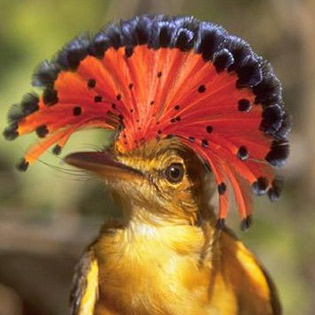
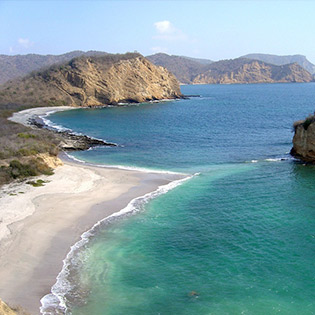

Overview
Machalilla National Park is named for the ancient people who once lived along this stretch of the Pacific Coast. The park was created to protect several unique habitats including the endangered tropical dry forest, the desert-like islands just off the coast and stunningly long stretches of beach. There are three distinct biomes - the coast, dry forest, and cloud forest. The dry forest comprises the majority of the park, and hosts several hiking trails that lead to prominent vistas. The park is comprised of 316,160 acres of marine and coastal habitat along the mainland and around the Islands of Salango and La Plata; the surrounding ocean encompasses Ecuador's only continental coral reefs. The park’s marine boundaries protect 40 percent of coastal fisheries in the country. La Plata Island is a major feeding ground for several shore birds, including pelicans, frigate birds, and boobies and protects the only known population of waved albatross outside of the Galapagos Islands. Humpback whales also breed within park boundaries.
Recommended Stay
Two to four nights.
When to go
Straddling the Equator as its name suggests, Ecuador is a year-round destination. However, there are different regional zones that have their own microclimates and best times to visit. Generally speaking, you may also wish to bear in mind the peak tourism season, which approximately from mid-December to end of January and again from June to August. On the Pacific coast and the lowlands that border it, there are two distinct seasons. The wet season paradoxically experiences more beach-friendly sunshine between January and May, although expect afternoon downpours, whilst a dry season from June to December sees the temperature drop and a greater and prolonged build-up of cloud.
Highlights
- Los Frailes is a gorgeous stretch of beach with its deep blue water, golden sandstone cliffs and fine-grained sand and is popular with Ecuadorians. Main beach is for visitors and a second, well-protected beach is reserved for nesting sea turtles.
- Isla de la Plata, often called the Poor Man’s Galapagos, is the nesting ground for Blue-footed, Red-footed, and Nazca Boobies as well as the Magnificent Frigate Bird. It is possible to hike several different trails on this very dry and often hot island. To reach the nesting grounds of the Red-footed Booby requires a day time visit of at least five hours. Snorkeling and diving are popular activities near Isla de la Plata. Divers love to visit between June and September when giant manta rays migrate between the island and the mainland. This same season is an excellent chance to spot whales. While snorkeling can be complicated by turbid water, a good day in the water means swimming beside giant sea turtles.
- Agua Blanca is a private community within Machalilla National Park hosting remains of one of the most ancient civilizations in South America, the Monteño, along with trails and a sulfur lagoon.
- Snorkeling and Scuba Diving. Twenty five percent (25%) of Machalilla National Park is a large marine area that is influenced by the Humboldt Current and boasts no less than 20 diving sites. These sites are home to coral formations and a large variety of marine species, including tropical fish, manta rays, turtles, various crustaceans, and whales.
Mindo Cloud Forest
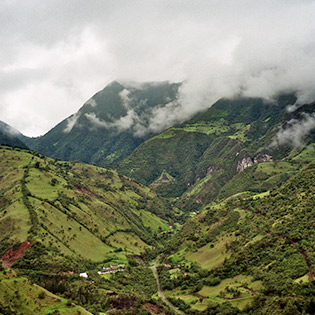
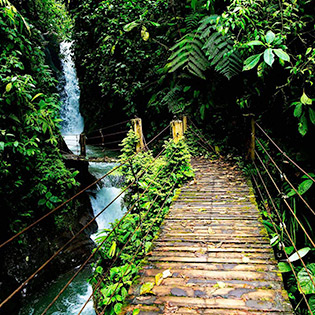
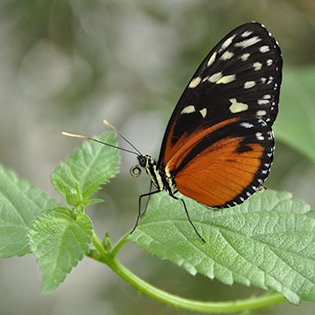
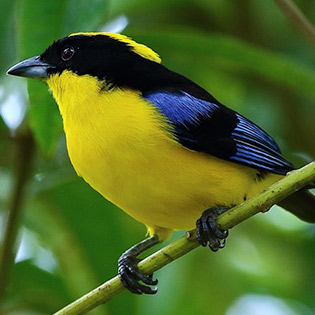
Overview
Andean cloud forests are a top priority for biodiversity conservation in the world since they are home to a remarkable number of endemic species very much endangered by human activities. Due to their unique geography and climate, the cloud forests of southern Ecuador and northern Peru are considered among the most diverse areas for this vulnerable ecosystem. Mindo Cloud Forest is set in a valley surrounded by the Andes Mountains. The rivers and elevation combine to create a lush cloud forest more than 100 square miles in size. The landscape and climate in Mindo are ideal for the more than 450 different types of birds, numerous species of exotic butterflies, and a variety of animals and reptiles who call the cloud forest home. Mindo is easily accessible, a mere 2-hour drive from Quito, a great option to get in touch with nature and enjoy of the amazing surroundings, scenery and climate of this protected area, where you can enjoy optional activities such as the hummingbird garden, chocolate tour, waterfalls, butterflies farm, canopy, rappelling, hiking into the forest, birds, etc..
Recommended Stay
Two to three nights
When to go
Ecuador is a year-round destination. However, there are different regional zones that have their own microclimates and best times to visit.
Ecuador is a year-round destination. However, there are different regional zones that have their own microclimates and best times to visit. Generally speaking, you may also wish to bear in mind the peak tourism season, which approximately from mid-December to end of January and again from June to August. The Andean Highlands including the capital Quito, has a dry season from June to September, when days are usually warm and sunny. Rainy season starts October and goes through mid-May possibly June. Best time for birdwatching is the rainy season.
Highlights
- Bird Watching The early morning hours are the ideal time for viewing and photographing opportunities. The cloud forest has over 400 different bird species and is one of the top 3 places in the world for population. Birding tours are more expensive than most opportunities in Mindo, but are also the most popular due to the regions top viewing opportunities that bring in bird enthusiast from around the world.
- Night Walks Guided nigh walks through the forests allow you to peer into the hidden night-time world full of snakes, frogs, and big eyed nocturnal mammals.
- Canopy Zip-Lining – Fly at high speeds through the cloud forest canopy. Choose to zip-line alone or upside down/superman with a guide on 10 cable lines that shoot you through the trees and over amazing landscapes.
- Hike the cloud forest to the Mindo Cascadas.
Trekking into the cloud forest is an absolute must! Take a taxi to the tarabita, or cable car, perched high overhead Mindo. The Mindo tarabita will carry you across the Rio Nambillo and the cloud forest valley below. - Fly through the trees on a Mindo canopy adventure.
It doesn’t matter if you’re a first-time zip liner or a pro flying over the trees with your arms spread wide. A canopy tour over a lush cloud forest is just thrilling! Fly across the cloud forest on 10 cables ranging between 500 feet and 1,600 feet long. - Learn about Mindo chocolate.
The first thing that strikes you as you learn about the process of going from cacao beans to chocolate is, “How on Earth did humans ever discover chocolate?!” There are numerous steps, several of which are not obvious at all. Whoever first made chocolate surely did so by accident! - Go tubing on the Rio Mindo.
River tubing is an awesome adventure activity for anyone who wants to feel adrenaline flowing - Explore the Cloud Forest by bike.
Mindo Biking is owned and directed by Mindo locals who wish to share their passion for biking, Mindo, and the beautiful country of Ecuador to all travelers.
Quito
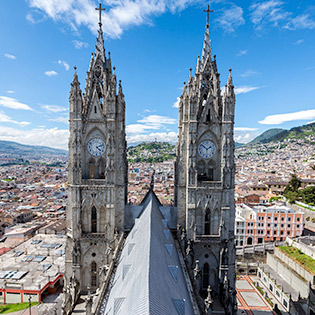
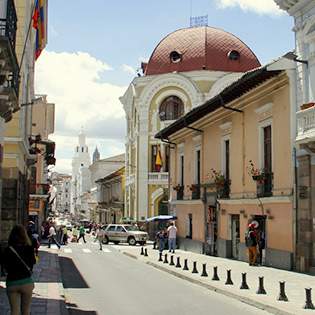
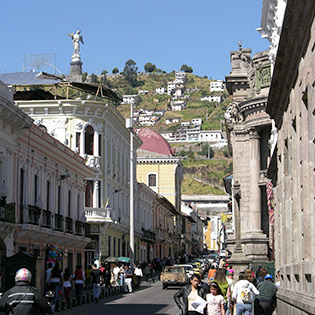
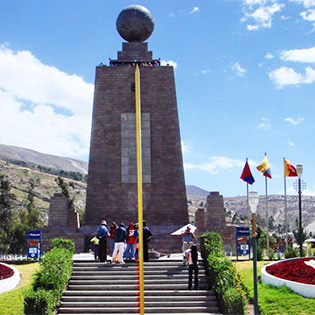
Overview
Ecuador’s capital city boasts a wonderful spring-like climate despite the fact it is only 14 mi. south of the equator. Quito is situated at 9,400 ft. above sea level, in a valley flanked by majestic mountains and on most days, several snow-capped volcanoes are clearly visible. The city is rich in history and boasts one of the largest, best preserved colonial quarters in the Americas. Modern Quito, where leading hotels and restaurants are located, is also home to the commercial and financial districts. Quito enjoys a privileged location, just two hours from a myriad of tourist attractions including indigenous markets, national parks, volcanoes, cloud forests teeming with wildlife, and the “Middle of the World” equatorial monument at “0 degrees and 00 minutes” latitude.
Recommended Stay
Two to three nights.
When to go
The Ecuadorian Highlands are blessed with a balmy climate year-round characterized by warm days, cool nights and steady temperatures averaging 65F. Best time to visit is during dry season (June-October) although rainy season normally offers sunny mornings and afternoons with potential evening showers.


